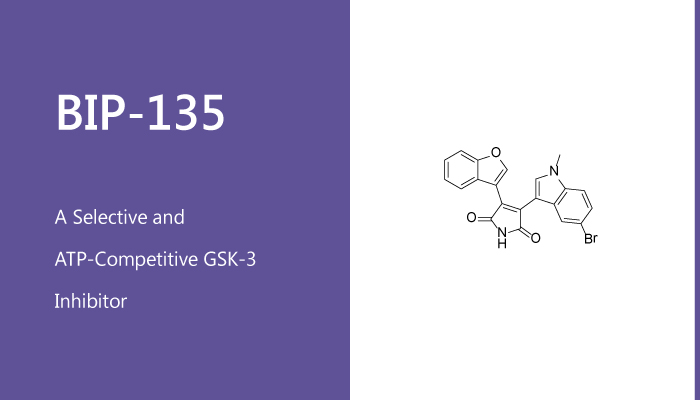Glycogen synthase kinase-3 (GSK-3) is a member of the serine/threonine kinase family. A number of human pathological conditions link to the upregulated GSK-3. This enzyme regulates a diverse array of intracellular processes through the phosphorylation of its protein substrates. In mammals, GSK-3 has two homologous isoforms, namely GSK-3α and GSK-3β. This multifunctional kinase is constitutively active in resting cells and can be physiologically inhibited by various signaling pathways. They include the PI3K/Akt mediated apoptosis cascade in stimulated cells through phosphorylation of residues Ser-21/Ser-9 (GSK-3α/β). Spinal muscular atrophy (SMA) is a major cause of lethality among infants in their early stage of life, and it remains as an untreatable disease. However, inhibition of GSK-3 elevates cellular SMN levels in SMA type I patient-derived fibroblasts. In this study, BIP-135 is a potent and selective ATP-competitive GSK-3 inhibitor, with IC50s of 16 nM and 21 nM for GSK-3α and GSK-3β, respectively.

BIP-135 increases the survival motor neuron (SMN) protein levels at a dose of 25 μM in human SMA fibroblasts. In addition, it has the typical bell-shaped dose-response curve due to some toxicity at higher concentrations. Meanwhile, it is a superior neuroprotective agent in the model of oxidative stress. Furthermore, BIP-135 does not appear to be toxic and is well-tolerated by the animals (no decrease in body weight). Moreover, BIP-135 prolongs the median survival time of Δ7 SMA KO mouse model of spinal muscular atrophy.
In summary, BIP-135 is a potent and reasonably selective GSK-3 inhibitor. Meanwhile, it is neuroprotective in a cortical neuron model of oxidative stress. More importantly, BIP-135 is able to elevate SMN protein levels in vitro and extend the median survival period of transgenic mice bearing a severe SMA phenotype.
Reference:
Chen PC, et al. ACS Chem Neurosci. 2012 Jan 18;3(1):5-11.